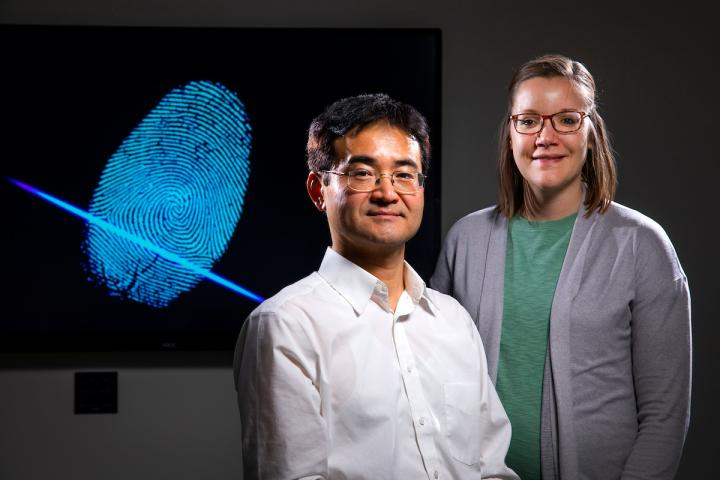Feb 19 2020
Fingerprints are revealing an increasing amount of details about the people who left them behind. Individuals would definitely know that the unique arches, loops, and whorls in a print can help identify a person.
 Chemists Young-Jin Lee and Paige Hinners may have found a way to determine when a fingerprint was left behind. Image Credit: Christopher Gannon.
Chemists Young-Jin Lee and Paige Hinners may have found a way to determine when a fingerprint was left behind. Image Credit: Christopher Gannon.
However, scientists are currently looking at the environmental and natural compounds within these fingerprints and how they can also provide clues regarding the ethnicity, gender, and lifestyle of a person.
But even as scientists come across new data in the fingerprints, they still have not discovered a method to establish a fundamental fact about a print—that is, how old is the print?
That information can possibly link a suspect to a crime scene. Chemists at Iowa State University are working to provide precisely this information.
What Happened to the Unsaturated Oils?
When Paige Hinners was utilizing a computer algorithm to impartially study the spread and degradation of fingerprint ridges over time—a potential method to establish a fingerprint’s age—she observed something else in her data. The unsaturated fatty oils present in a fingerprint were vanishing from her measurements.
“If we’re losing them, where are they going?” asked Hinners, who finished her doctorate in analytical chemistry in December at Iowa State University and currently working as a senior chemist for Ames-based Renewable Energy Group Inc.
Hinners was also a graduate student in the research team of Young-Jin Lee, a chemistry professor from the College of Liberal Arts and Sciences at Iowa State University. During that time, she worked on the fingerprint project. Madison Thomas, a former undergraduate student from Iowa State University, also contributed to the study.
The researchers ultimately found the answers: As triacylglycerols, the unsaturated fats to be precise, vanished from the data, other compounds that resulted from ozonolysis, or reactions with ozone, began to show up.
This finding led to many steps and trials to verify that ozone was responsible for the degradation of the unsaturated fats present in fingerprints. This eventually allowed the researchers to conclude that with additional research, this can become a valuable tool to establish a fingerprint’s age.
The discovery made by Iowa State chemists was newly published online by the Analytical Chemistry research journal and has appeared on a supplementary cover of the present print edition.
The study shows how the Iowa State chemists employed a tool known as matrix-assisted laser desorption/ionization mass spectrometry imaging. This technology involves utilizing a laser to examine compounds that are left on a surface and subsequently recording the electrical charge and mass of every component inside a sample, for example, the numerous oils present in a fingerprint.
The new imaging tool enabled the chemists to monitor the degradation of unsaturated oils caused by reaction with atmospheric ozone.
How Precise is the Technique?
Right now, we can measure the number of days (since a print was left). It’s easy to tell one-day old from fresh. There’s no doubt about that.
Paige Hinners, PhD Scientist, College of Liberal Arts and Sciences, Iowa State University
In addition, the chemists tested whether the powder used to render the fingerprints visible would impact the potential of mass spectrometry to examine the degradation and aging of fingerprints. It was found that the powder did not impact the ability of the researchers to obtain data and establish the aging of fingerprints.
“This Might be the Way”
Lee elucidated the research as a proof-of-concept project, and hence, the testing was restricted to fingerprints obtained from three people. The study was supported by a $362,000 grant from the National Institute of Justice.
This data indeed revealed the individual variations in the number of unsaturated oils present in fingerprints, the speed of reaction with ozone, and the ensuing degradation, stated Lee.
Therefore, additional research is required to interpret the varying levels of fatty oils present in individuals and how that would have an impact on degradation. Moreover, the team is exploring how environmental factors like humidity are likely to have an impact on reactions with ozone.
The National Institute of Justice awarded a new $516,800 grant that will allow the scientists to continue their study on fingerprint-aging. This grant will also allow the team to explore how the presence of fatty oils in fingerprints could provide clues about the health and other characteristics of a person.
According to Lee, while the method used for establishing fingerprint aging requires additional research, the concept has been verified.
We can measure decomposition of unsaturated triacylglycerols as a function of time. We’ve studied the mechanisms and proved what’s happening. By measuring how fast it’s decaying, we can come up with an idea of how old it is.
Young-Jin Lee, Professor, Department of Chemistry, Iowa State University
This is the most interesting part of the study, which started by looking in another direction.
When we reproduced this with each person, it was fairly consistent. And so we learned this might actually tell us how old a fingerprint actually is. This might be the way—that’s exciting.
Paige Hinners, PhD Scientist, College of Liberal Arts and Sciences, Iowa State University
Hinners still serves as a resource for Lee’s research team.